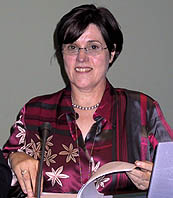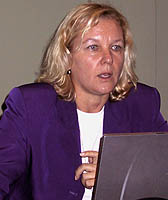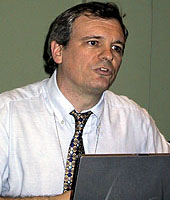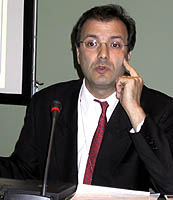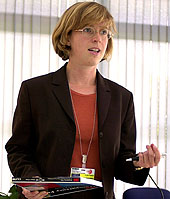|
|
|||||||||||||||||||||||||||||||||||||||||
|
|||||||||||||||||||||||||||||||||||||||||
|
Events convened on Monday, 29 October 2001 |
|
Status
report on GEF capacity-building efforts
Presented by the Global Environment Facility (GEF) This event provided an overview of the status, scope and possible future directions of GEF capacity-building efforts in response to Convention guidance.
Vaish explained that the CDI resulted in new methods for recipient countries to access GEF resources for capacity building. Initial self-assessment of capacity needs is one such method, and has been approved by the GEF Council. It provides expedited approval procedures for requests of up to US$200,000, and makes available grants of US$25,000 for least developed countries (LDCs) and small island developing States (SIDS) for the preparation of proposals to carry out self-assessments of capacity needs.
Other proposed methods, which are undergoing further consultation, include a programme for critical capacity-building activities in LDCs and SIDS, targeted capacity-building projects, and enhanced attention to capacity building in regular projects. Vaish emphasized that these projects do not displace the GEF's enabling activities. Annie Roncerel, United Nations Institute for Training and Research (UNITAR), provided an overview of the Guide for Self-Assessment of Country Capacity Needs for Global Environmental Management, which outlines methodologies for assessing capacity-building needs. The Guide describes how to: design and execute national capacity needs self-assessments (NCSAs); conduct capacity self-assessments for climate change, biodiversity and land degradation; prepare an NCSA document; and identify next steps. Discussion: Participants discussed the role of national focal points in the assessment process and the importance of broad consultation, the need for assessments to be country-driven, the efficiency of regional approaches, the need to ensure equitable distribution of financing for capacity building to all developing countries, and means for making the consultative processes more inclusive.
Please visit the UNFCCC's "On Demand" webcast page for RealVideo coverage of this event |
|
Policies and measures to reduce greenhouse gas emissions Presented by the International Energy Agency (IEA) Kristi
Varangu, IEA, outlined past, present and future policies and
measures to save energy and reduce greenhouse gas emissions.
She highlighted several possible policy options, including the
use of taxes and market mechanisms to encourage sequestration
and fuel-switching. She explained that IEA member countries
are using a variety of policy instruments, such as tradeable
permits, and regulatory measures to increase energy efficiency
in the transport, industry and energy sectors. Varangu concluded
that while the overall level of mitigation resulting from existing
policies remains indeterminate, current trends suggest that
they are inadequate to halt growth in emissions. Lewis M.
Fulton, IEA, presented an IEA publication on options and strategies
for saving oil and reducing carbon dioxide (CO2)
emissions in the transportation sector. The book discusses potential
policy options in: new light-duty vehicle fuel economy; on-road
fuel economy; vehicle travel reduction; alternative fuels; and
freight transport. Fulton highlighted effective policy options,
including: fuel economy improvement; in-use fuel economy; innovative
parking measures; toll rings; and subsidy reform for bio-fuels. Benoit
Lebot, IEA, presented findings on energy savings and reductions
in CO2 emissions from appliances. Lebot
stated that since 1990, OECD residential electricity use has
grown by 23 percent. Policies considered to ameliorate the increase
include: building codes; minimum energy performance standards
(MEPS); labeling; market transformation programmes; financial
incentives; and research and development. Lebot concluded that
codes and standards deliver large, predictable and lasting savings,
and that labeling and MEPS can be cost-effective means of reducing
emissions.
|
|
The Integrated Global Observing Strategy (IGOS) Presented by the Japanese delegation in collaboration with the Global Climate Observing System (GCOS) Naomasa Murakoshi, National Space Development Agency of Japan, described the Integrated Global Observing Strategy (IGOS), a partnership between various international agencies which aims to develop global observing systems for ocean and terrestrial carbon sources and sinks. IGOS produces comprehensive global, regional and national data to support the environmental information needs of scientists, operational environmental programmes, and national and international decision makers.
Freibauer concluded with five preliminary recommendations for the scientific community and funding agencies: improve existing data; fill in gaps in under-sampled regions, including tropical continents and the southern oceans; develop a modeling framework of various spatial and temporal resolutions, with a focus on linking scale-crossing techniques with advanced process studies to diagnose carbon cycle fluxes and their evolution; develop a multiple constraint approach in a systematic way; and establish a process to build confidence in necessary techniques, including the validation of technologies such as satellite CO2 column measurements. Alan Thomas, GCOS, highlighted the importance of integrating observation systems and addressing deficiencies in the observation systems of non-Annex I countries.
|
|
For
further RealVideo coverage of these and other side-events at COP-7,
please visit the UNFCCC's "On Demand" webcast page |
|
| The Earth Negotiations Bulletin (ENB) on the side is a special publication of the International Institute for Sustainable Development (IISD) in cooperation with the United Nations Framework Convention on Climate Change (UNFCCC) Secretariat. The Editor of ENB on the side is Kira Schmidt <kira@iisd.org>. This issue has been written by Fiona Koza <fiona@iisd.org>, Dagmar Lohan <dagmar@iisd.org>, and Kira Schmidt <kira@iisd.org>. The Digital Editors are Andrei Henry <andrei@iisd.org>, Leila Mead <leila@iisd.org> and Kenneth Tong <ken@iisd.org>. Funding for publication of ENB on the side at COP-7 is provided by the UNFCCC Secretariat. The opinions expressed in ENB on the side are those of the authors and do not necessarily reflect the views of IISD and funders. Excerpts from ENB on the side may be used in non-commercial publications only and only with appropriate academic citation. For permission to use this material in commercial publications, contact the Managing Editor at <kimo@iisd.org>. Electronic versions of these issues of ENB on the side from COP-7 can be found on the Linkages WWW server at http://enb.iisd.org/climate/cop7/enbots/. | |
|
|
| © 2001, IISD. All rights reserved. |
|




